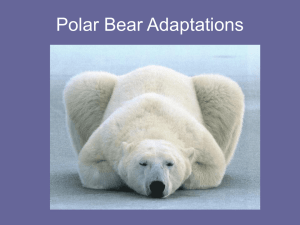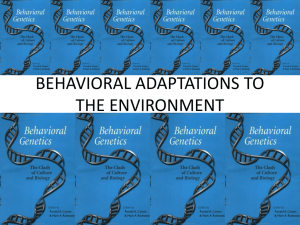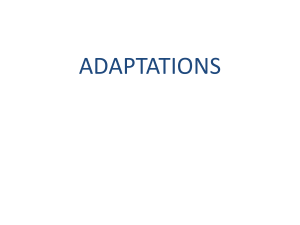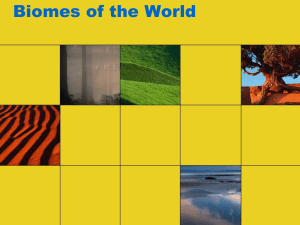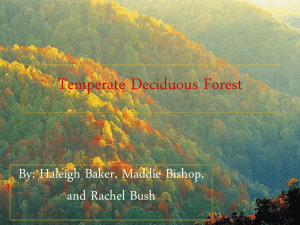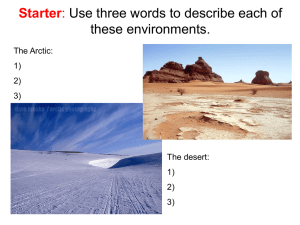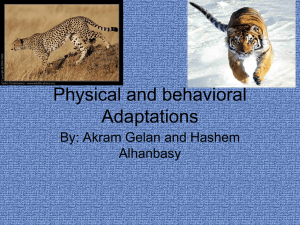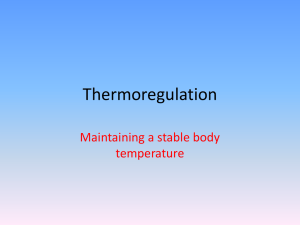Animal Adaptations Power Point
advertisement
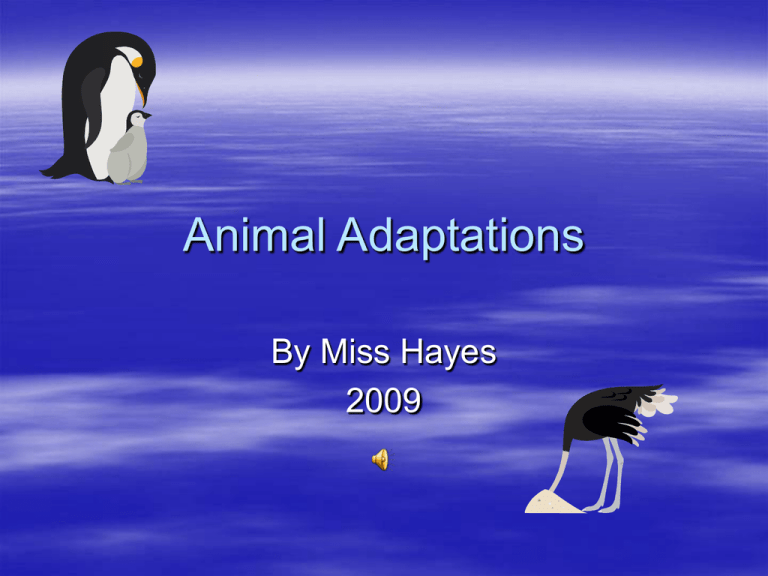
Animal Adaptations By Miss Hayes 2009 Adaptations, Habitats, Biomes Essential Questions Read through the following presentation with your group and teacher. See if you can answer these questions by the end What is an adaptation? What is the difference between physical and behavioral adaptations? What is a biome? What are the major biomes? What kinds of animals belong to each biome? How do biomes affect animal adaptations? How to animal adaptations change over time? What is an adaptation? How a person or animal changes or “adapts” to survive. We change how we dress. When the weather gets cold we wear coats and long pants. Similar to this animals must adapt to changes in their surroundings. What do all animals need? Air (oxygen), water, shelter, food What animals do or how they behave to get these needs is called an adaptation. Physical and Behavioral Animals adapt in many ways. There are two types of adaptations. Physical and Behavioral. Physical is how an animal looks. It is it’s physical features such as beaks, tails, claws, and much more. A skunk has a physical adaptation that protects it from harm. Do you know what it is? Behavioral is how an animal behaves. If your teacher says you had great behavior, he or she means you acted very well. Behavioral Adaptations are how an animal acts to help it survive in its’ habitat. There are two types of Behavioral Adaptations Taught and Instinctive. Taught is something like talking to humans. Someone had to teach you how to talk. Instinctive is like a baby crying. Babies know how to do it from birth. It does not have to be taught. We will explore some examples of physical and behavioral adaptations now. Physical Adaptations Physical adaptations may be how many fingers an animal has, how thick its fur it, or how it changes to attract a mate. Physical adaptations do not form overnight. They can take hundreds of years to transform and usually change because of the climate. With today’s constantly changing environment, animals habitats or living places are changing. An animal has to readjust to that new surrounding or climate. If they can’t the animal dies. You will learn more about how climate changes and then with time it forces animals to change and adapt later in this lesson. Adaptations- Physical Mimicry The Viceroy Butterfly mimics the Monarch. The Monarch is poisonous and birds know not to eat it. The Viceroy is not poisonous but because it looks similar, many animals will not eat it. What other animals use mimicry? Camouflage The chameleon’s light brown coloring keeps it safe from harm. It matches the trees and brush it lives in so predators cannot see it. The chameleon only changes color when in immediate danger. What other animals use camouflage? Adaptations- Physical Defense The skunk uses a special musk to spray when it feels it is facing danger. Bombardier beetle- a beetle that has a special defense feature. It mixes two chemicals in its body and shoots the chemicals mixed in its body from its abdomen at predators for protection. Behavioral Adaptations Migration This is when animals move from one place to another in search of food or to find a warmer place to live. Hibernation/Estivation When an animal goes in a dormant or inactive state to avoid extremely cold weather conditions. Brown bears hibernate in the winter. Estivation is the same as hibernation but is done by animals trying to avoid very hot conditions. Behavioral Adaptation- Caring for an animals’ young Crèche Crèche is the term used for how a mother duck leads her ducklings as she searches for food. In a crèche one female leads the group of ducklings and the other trails in the back guarding them from danger. This can be considered an adaptation used to care for the young. Spiders have many spider eggs at one time; therefore they cannot all live in the same area. As a special adaptation and means of survival young spiders find a pace to live by ballooning. They raise their abdomen or rear, spin a long strand of silk and let the breeze carry them to a new home. Adaptations are everywhere! There are many more types of adaptations both physical and behavioral. What other kinds of adaptations of animals do you know? You will use the following WebQuest to find even more adaptations! Now it’s time to learn about where these animals live and how that affects their adaptations. Biomes There are six major types of biomes where all animals could live and “adapt” to in order to survive. Freshwater -Includes wetlands, streams and rivers, ponds and lakes. Animals that live here require low salt intake. Temperature of the water changes drastically with the seasons. (fish such as catfish, shrimp. ducks, turtles, snakes, birds) Marine – Cover about 75% of Earth’s surface. Marine includes oceans, estuaries, and coral reef. High salt concentrations. (mammals such as dolphins and whales, crabs, worms, octopuses) Desert –Cover about 20% of Earth’s surface. Few animals live in very hot deserts because the desert offers little protections from the hot sun. Semiarid, coastal, coastal, and cold deserts contain more animals. (rabbits, skunks, owls, snakes, jack rabbits, mice, coyotes, and badgers) Biomes- Continued Forest (Taiga)- There are three types. tropical, temperate, and boreal. Tropical-near equator (birds, bats, small mammals.) Temperate-eastern North America, northeastern Asia, and western and central Europe (squirrels, rabbits, skunks, birds, deer, mountain lion, bobcat, timber wolf, fox, and black bear.) Boreal-short, moist summers, long cold winters (hawks, small mammals, bats, lynx, bears) Grassland– Two types savannah and temperate (includes prairies). Africa, India, South America. (Savannah-giraffes, zebras, buffaloes, kangaroos, mice, moles, gophers, ground squirrels, snakes, worms, termites, beetles, lions, leopards, hyenas, and elephants.) (Temperate- gazelles, zebras, rhinoceroses, wild horses, lions, wolves, prairie dogs, jack rabbits, deer, mice, coyotes, foxes, skunks, badgers, blackbirds, quails, sparrows, hawks, owls, snakes, grasshoppers, and spiders) Biomes- Continued Tundra- Two types; Arctic and Alpine. Arctic is coldest of all biomes. Tundra means “treeless.” characterized by short growing seasons and reproduction seasons. Arctic- Northern Hemisphere, North Pole (lemmings, caribou, arctic hares, squirrels, arctic foxes, wolves, polar bears, snow buntings, falcons, loons, terns, snow birds, mosquitoes, flies, moths, grasshoppers, black flies, salmon, and trout) Alpine- very high mountaintops of Alaska and Washington. (marmots, mountain goats, sheep, elk, beetles, grasshoppers, butterflies) How did you do? What is an adaptation? What is the difference between physical and behavioral adaptations? What is a biome? What are the major biomes? What kinds of animals belong to each biome? How do biomes affect animal adaptations? How to animal adaptations change over time? Credits Biome pictures http://www.ucmp.berkeley.edu/exhibits/biomes/index.php
